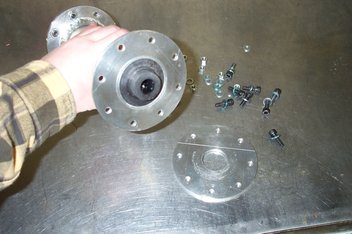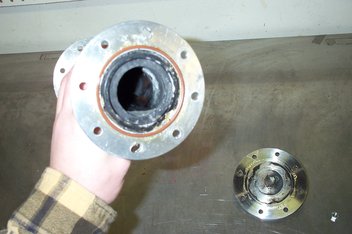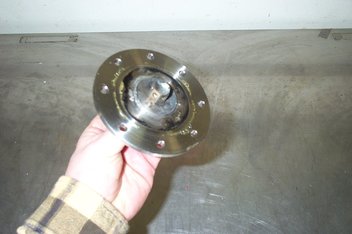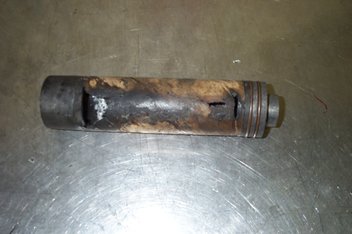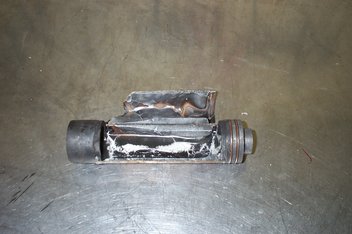First Static Test Fire
December 31, 2003

The propulsion team has successfully performed the first test firing of the gaseous oxygen/ paraffin hybrid rocket motor.
This is a small lab-scale motor that will be used to evaluate the possibility of using paraffin wax as a fuel for a future flight article motor.
The primary goal of this first round of testing was as follows:
1) To see if we could get the motor to safely operate
2) Evaluate the paraffin grain after firing.
Two tests were conducted and they both were successful in meeting our goals.
Movies
Test Fire #1 (Camera 2)
Test Fire #1 (Camera 1)
Test Fire #2 (Camera 1)
Test Fire #2 (Camera 2)
The Tests:
Present for the test was Evan Waymire, Tim Russel, Andrew Greenberg, Eric Hettinger and Brian O’Neel. The tests were conducted on private property near the Clackamas River in a remote area outside of Estacada, Oregon. The weather was cold and rainy so we only performed two tests. We started about 1:00pm and ended at 3:30pm
The first test was for approximately 7 seconds. We wanted to fire the motor for less that it’s 12 second calculated time to protect the combustion chamber from hot gasses in the event the paraffin did not regress in the fashion we expected.
The first burn seemed fairly consistent and was extremely loud :) The igniter fired on time and the motor immediately came to life when the oxygen ball valve was opened. The oxygen was manually shut down at 6.5 seconds and then purged with nitrogen.
The second test was to be only 3 seconds so we could get a better look at the remaining paraffin after the test. This was decided upon because the first paraffin grain seemed to have a very chaotic burn pattern. In order to achieve the 3 second burn time the oxygen needed to be manually shut down due to a problem with the return spring on the pneumatic actuator. In the actual test it took much longer to cut the oxygen off. It took a few seconds to close down the valve at the tank and then bleed out the 25 feet of oxygen line. During this process the nitrogen purge came on and we had both oxygen and nitrogen going into the combustion chamber for a significant period of time. This can be seen from the video footage.
The Results:
In both the first test and the second test the paraffin had completely burned or melted away to the cardboard liner. There was evidence of charring of the cardboard on both tests were the paraffin was missing but other areas that had almost 0.5” of paraffin remaining. A burn pattern did not seem to be evident. There was a large wavy texture remaining in the paraffin. It is uncertain whether this was from the burning process or if it occurred after burning by residual heat in the chamber and nozzle or if it may have been caused by the purge nitrogen blowing through the combustion chamber.
Pooling of the paraffin was also notice at the bottom of each motor. This pool was approximately 0.25” deep on each motor indicating that there was a large amount of liquid paraffin in the motor during firing or immediately after firing.
There was no visible sign of damage to either the aluminum combustion chamber or the brass injector. No erosion was detectable to either the nozzle or the premix sleeve. Upon completion of firing the motor was only slightly warm to touch near the injector but became relatively hot near the nozzle. The motor appears to be in good shape to fire again.
All in all the test were good because we were close enough with our design and calculations to get a working motor and were able to take a look at the paraffin afterwards
Things to Consider:
During the second test there was a misfire due to the igniter coming out of the ignition ring. With the test motor being contained with a bolted flange method it took a considerable amount of time to reinstall another igniter. This ignition method needs to be rethought to perhaps develop a new or more robust method of igniting the motor.
The other major problem was the pneumatic ball valve that controls the oxygen flow did not perform as predicted. The ball valve will open fine under the 1000 psi from the Tescom regulator but will not close once the control computer tells it to. In tests it seems to do this o.k. when subjected to 500psi but not 1000psi. The Watts pneumatic actuator has a return spring that is use to close it. We need to investigate a way to get the valve to close such as a stronger return spring or possibly a pneumatic return.
We also need to consider reducing the operating time of the motor. 7 seconds seems to be about the maximum time right now and still not jeopardize the strength of the aluminum due to heating.
What next:
The next step is to start gathering information from the motor. This will primarily be: Load, pressure and burn rate. This will be accomplished with a data acquisition system interfaced to a load cell, pressure transducer and some undetermined way to sense the burn rate.
This may call for a redesign of the test stand and some revised interface electronics. Once this is done we will do another round of test firing to collect data.
